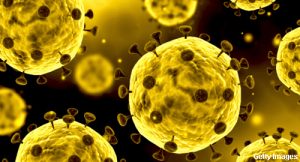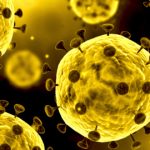 In December 2020, University of California, San Diego (UCSD) Health began vaccinating healthcare workers against the severe acute respiratory syndrome caused by SARS-CoV-2 (COVID-19) with mRNA vaccines: BNT162b2 (Pfizer-BioNTech) and mRNA-1273 (Moderna). Even after the vaccine rollout, UCSD Health continued its daily screening of all workers for COVID-19 symptoms or exposure. Those who were positive during the screening were tested for COVID-19 infection.
In December 2020, University of California, San Diego (UCSD) Health began vaccinating healthcare workers against the severe acute respiratory syndrome caused by SARS-CoV-2 (COVID-19) with mRNA vaccines: BNT162b2 (Pfizer-BioNTech) and mRNA-1273 (Moderna). Even after the vaccine rollout, UCSD Health continued its daily screening of all workers for COVID-19 symptoms or exposure. Those who were positive during the screening were tested for COVID-19 infection.
Jocelyn Keehner, MD, a third-year infectious disease fellow at UCSD Health, and colleagues used the vaccination and testing data collected during this process to calculate vaccine effectiveness for every month from March 2021 to July 2021. The investigators documented a dramatic change in vaccine effectiveness from June 2021 (94.3%) to July 2021(65.5%). They believe this decrease resulted from both the emergence of the delta variant and the waning immunity from the vaccination. Their findings were published on Sept. 30, 2021, in the New England Journal of Medicine.1
The San Diego Experience
Prior to the availability of a vaccine, healthcare workers at UCSD Health experienced a dramatic increase in SARS-CoV-2 infections. However, the number of positive tests decreased as the workforce became vaccinated. At the end of March 2021, UCSD Health had vaccinated 76% of its workforce. By the end of June 2021, 87% of the workforce was vaccinated, and by the end of July 2021, close to 99% of the workforce was fully vaccinated.
According to senior author Francesca J. Torriani, MD, an infectious disease specialist at UCSD Health, the study was prompted by the fact that in June 2021 UCSD Health began documenting breakthrough COVID-19 infections. Up until that time, these cases had been rare.
The spring and early summer of 2021 also saw two notable changes in the pandemic in San Diego: In April 2021, UCSD Health documented its first cases of the delta variant in healthcare workers. In June 2021, California decreased its pandemic restriction and community mask use decreased. Thus, the area experienced an increase in infections in the spring, and the delta strain became the dominant strain in the area.
Waning Protection Strains Health System
Of the 227 UCSD Health infections that occurred from March 1 to July 31, Dr. Torriani’s team found that 130 (57.3%) occurred in individuals who were fully vaccinated. They questioned whether the infection in vaccinated workers was due to increased viral load from the delta variant or waning immunity from the vaccines.
When the team analyzed the July case rates according to the month in which workers with COVID-19 completed their vaccination series, they found the attack rate for the unvaccinated was higher than that of the vaccinated. The July attack rate among unvaccinated persons was 16.4 per 1,000 persons (95% confidence interval [CI], 11.8 to 22.9). In workers completing vaccination in January or February, the attack rate was 6.7 per 1,000 persons (95% CI, 5.9 to 7.8). This finding stood in contrast to the attack rate of 3.7 per 1,000 persons (95% CI, 2.5 to 5.7) among those who completed vaccination during the period from March through May. Thus, although the vaccination was providing protection against severe disease, it was more effective during the first three months post vaccination.
Dr. Torriani notes the workforce had a mean age of 37 years and the study encompassed “a young cohort of healthcare workers who are quite healthy.” Both vaccinated and unvaccinated workers had symptoms, 83.8% and 88.9%, respectively, but Dr. Torriani reports that when the vaccinated individuals did get sick, they experienced very mild disease.
“Disease means that people have to stay home and isolate and not go to work,” Dr. Torriani says. Because of this protocol, the wave of infection put a strain on the healthcare system even though individuals were not particularly ill.
“We’re not worried about severe disease, but we worried about infectious disease in general,” says Dr. Torriani. Thus, she was disappointed when, at their September 2021 meeting, the Advisory Committee on Immunization Practices (ACIP) recommended against booster vaccination for persons with frequent occupational or institutional exposure to SARS-CoV-2.2
However, Dr. Torriani was grateful when director of the U.S. Centers for Disease Control & Prevention (CDC), Rochelle Walensky, MD, MPH, overruled the ACIP recommendation, enabling healthcare workers to receive a booster dose based on their individual benefits and risks. As justification for her decision, Dr. Walensky cited the implications of waning immunity against infection in healthcare personnel and other frontline workers.
Dr. Torriani says she is pleased by “the current push toward simplifying the criteria for boosters by opening boosters to all adults.”3
Lara C. Pullen, PhD, is a medical writer based in the Chicago area.
References
- Keehner J, Horton LE, Bikin NJ, et al. Resurgence of SARS-CoV-2 infection in a highly vaccinated health system workforce. N Engl J Med. 2021 Sep 30;385(14):1330–1332.
- Mbaeyi S, Oliver SE, Collins JP, et al. The Advisory Committee on Immunization Practices’ interim recommendations for additional primary and booster doses of COVID-19 vaccines—United States. MMWR Morb Mortal Wkly Rep. 2021 Nov. 5;70(44);1545–1552.



